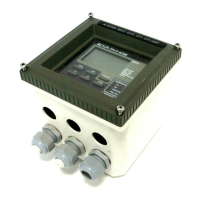IM 12B6B3-E-H
10-6 Appendix
10-5. Set up for Pfaudler Type 18 sensor
The PH402 is intended to measure with all sorts of pH sensors, including the Pfaudler Type 18 sensor. The
Pfaudler design of dual membrane system uses two enamels of differing sensitivity. The first a pH sensitive
membrane, and the second one that responds to Na
+
and K
+
and acts as a reference.
The analyzer has dual high impedance inputs which measure perfectly even with very high impedance sen-
sors. However, the impedance measuring system (diagnostics) needs to be set up for best performance.
10-5-1. General set up
1. Set impedance measuring hardware. This is done by the use of links on the terminals adjacent to the
input terminals. For the Pfaudler system, this means that the terminals should have the links disconnect-
ed in order to set for HIGH/HIGH impedance measuring.
2. Set the impedance check in software. Use codes 03 & 04 to enable the measurement and set for high
impedance and configure appropriate limits.
Code 03 set to 1.0.1 Iow limit 1 Megaohm
high limit 1 Gigaohm
Code 04 set to 1.0.1 Iowlimit 1 Megaohm
high limit 1 Gigaohm
3. Set the temperature compensation sensor as 100 Ohm Platinum RTD with service code 10.
Code 10 set to 1 100 Ohms Pt.
The system will now respond properly to the Pfaudler type 18 sensor, and the other functions of the EXA
analyzer will need to be set in the normal way to suit the use to which the loop is being put. Output ranges,
control functions and alarms should all be set as described elsewhere in this manual.
10-5-2. Calibration set up
4. The alternative Zero point (calibration and display) according to IEC 746-2 may be enabled in service
code 27, and set in the MAN.CAL routine. A value of 10.5 pH is a good starting point for the Pfaudler 18
sensor.
5. Where lab test data are available for the sensor, service code 23 can be used to set values for ITP &
Slope (and As pot for parameter 2 when enabled).
(This method can be useful for the type 18 sensor, as it is not usual to perform regular calibrations on this
system as with normal sensors. This is because the system may well respond differently, to ordinary buffers,
than with the process solutions. The procedure is to determine the temperature response (ITP) and the sen-
sitivity (Slope) of the sensor, and enter these values in code 23.)
Because this is a rather complex procedure, it is recommended instead to use the default settings of ITP =
7.00, and Slope = 100 %, and make a single point (MAN.CAL) calibration in the process at the working
temperature, and at the normal operating (control setpoint) pH. This ensures that the desired control point
will be measured accurately, even if there may be small deviations when there is a big deviation from the
setpoint. This of course has no effect on the accuracy of a control loop. The special construction of the
Pfaudler sensor ensures that there is practically no drift in the calibration. All that is necessary is to keep the
sensor membranes clean. This is best done by cleaning with low pressure steam, which restores the original
condition of the sensor, including the original calibration values.

